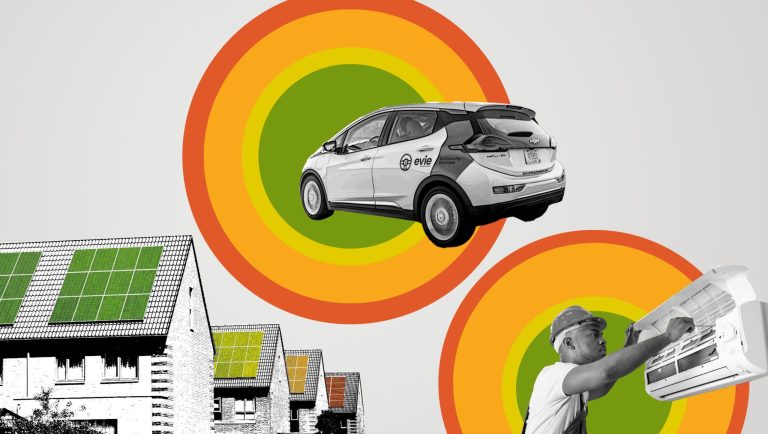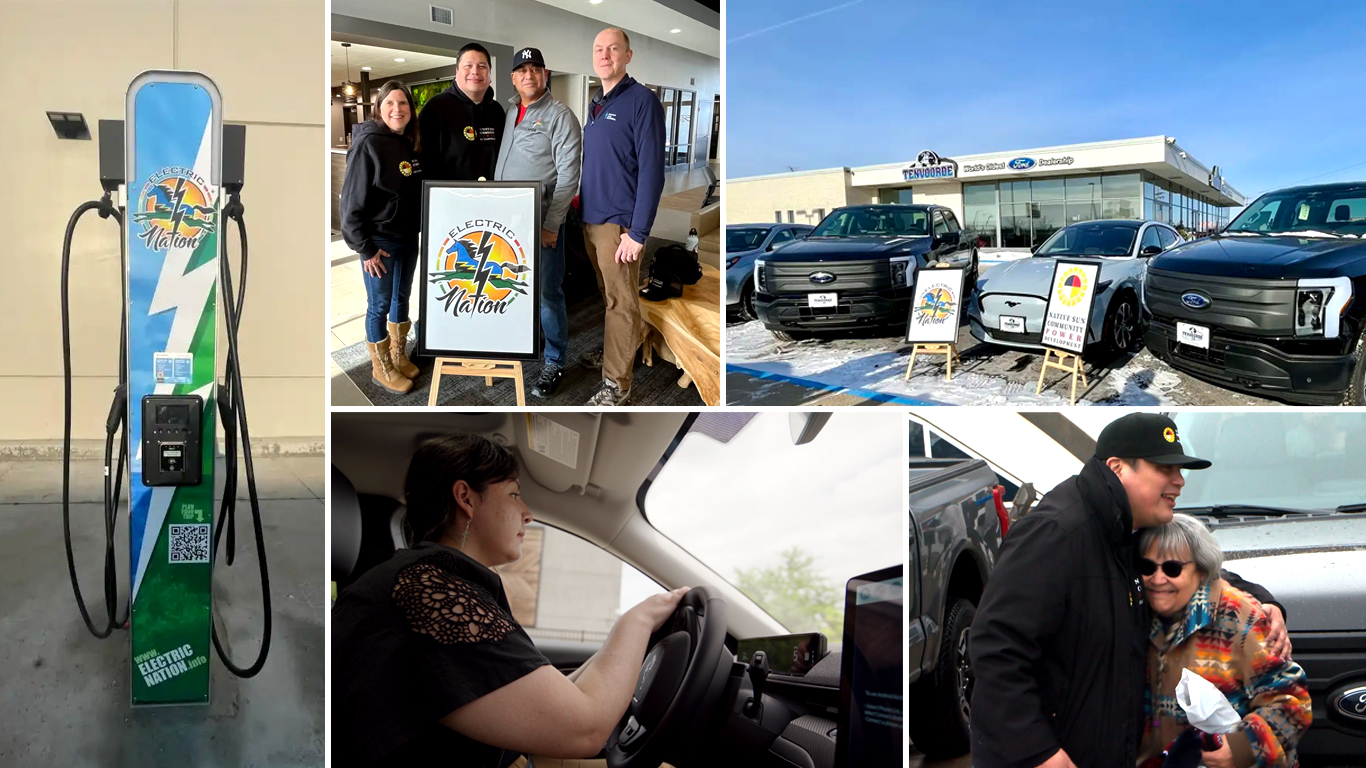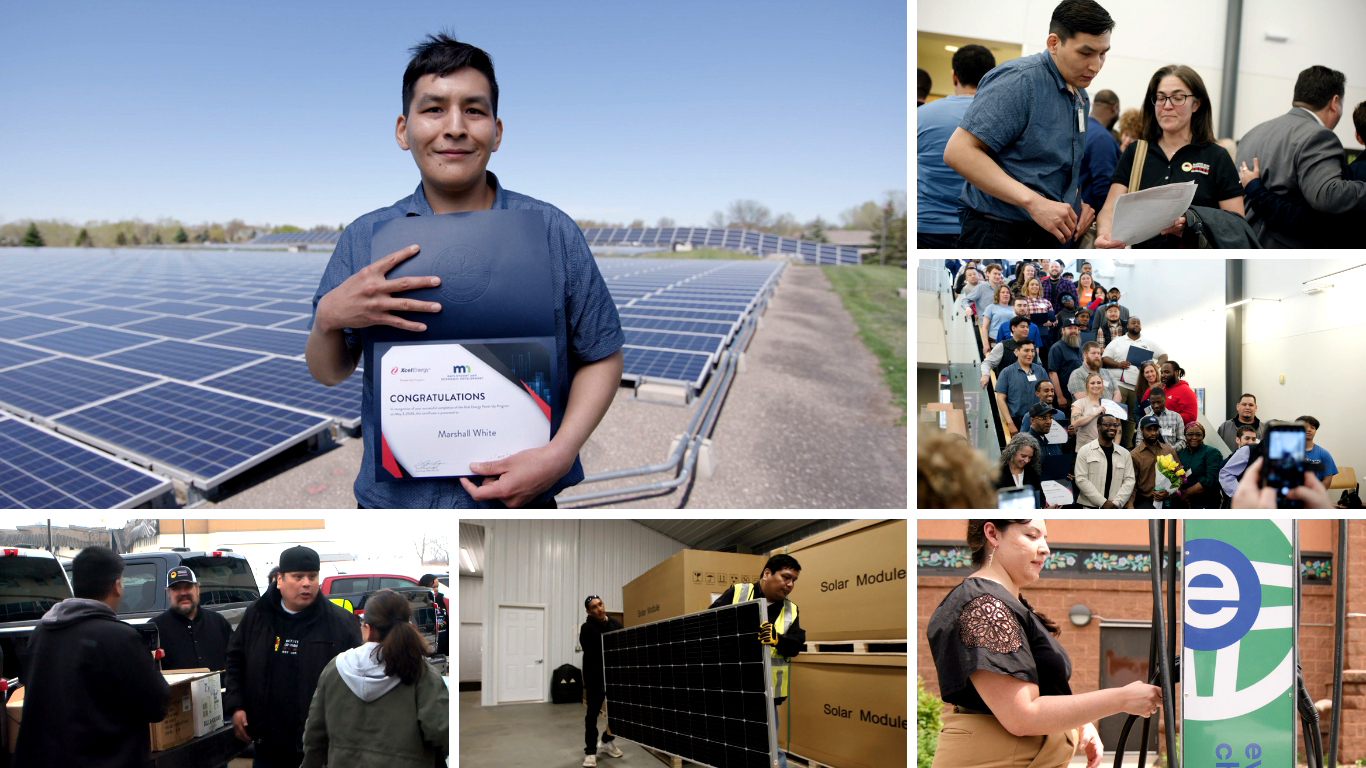
Category:Impact Story11 min read
Category:Impact Story11 min read
The construction of over 122 electric vehicle charging stations has begun, connecting Minnesota’s Tribal communities along major corridors with neighboring Tribes in North Dakota, South Dakota, Wisconsin, and Michigan. Dubbed Electric Nation, the project led by Native Sun Community Power Development will link 23 Tribal nations across the Upper Midwest with chargers, while also delivering 16 electric vehicles, from trucks to shuttles, to Tribal fleets across the region. Poised to reshape the future of energy and transportation for the state’s Indigenous communities, the project—among other Native-led initiatives—represents a spark for Tribal sovereignty, climate action, and the transition to a green economy.
Robert Blake is the founder and executive director of Native Sun and a member of the Red Lake Nation. Above all else, he is dedicated to fostering energy sovereignty among Minnesota and Midwest Tribal nations. What began as a visionary proposal has evolved into a groundbreaking initiative challenging conventional energy paradigms and paving the way for a more just and equitable clean energy future.
Video by Line Break Media with footage from Clean Energy Economy MN, Lakeland PBS, and Sandia National Laboratories.
“Energy sovereignty is like the backbone of Tribal sovereignty, because I think it’s where people can really be self reliant,” said Blake. The concept of the Electric Nation project was to bring Tribal nations together in the wake of protests to the Line 3 and Dakota Access pipelines, as a form of resistance by Native people to fossil fuel infrastructure development.
“We often talk about justice and its intersection with clean energy,” says Tenzin Dolkar, Midwest Climate & Energy Program Officer at McKnight Foundation. “Many people are beginning to think creatively about how to reimagine and rebuild a sustainable green economy. Native Sun, along with its Tribal community partnerships, is leading this innovative work, and we are thrilled to support their efforts.”
Tribal energy sovereignty is rooted in the inherent rights of Indigenous communities to lead, own, control, and manage their energy resources. This means that Tribal governments get to be the ones to determine which projects are built on their land.
Across the United States, Tribal nations have long been marginalized in energy development, often forced to rely on external entities for power and resources while bearing the brunt of pollution from traditional energy sources and nuclear waste. This dependency has not only hindered economic development and expression of sovereignty, but has contributed to a cycle of resource poverty.
“Energy costs create huge economic burdens in Native communities,” says Cody Two Bears, founder and executive director of Indigenized Energy. “Many reservations have homes scattered over large areas, far from a utility grid. As a result, Indigenous people typically pay more for energy than communities off reservations.”
The Department of Energy’s Office of Indian Energy issued a report citing that 16,805 Tribal homes in the U.S. were unelectrified—putting some of the most vulnerable people in the community, Tribal elders and children, at risk. Indigenized Energy, a capacity-building organization that works directly with Native Tribes to pursue energy transformation, began work in 2023 on the Northern Cheyenne Tribe’s first residential solar project, alongside its partners.

Native Sun and Indigenized Energy are part of a larger movement of organizations creating opportunities for Tribal energy sovereignty across the United States. Indigenized Energy, part of the Northern Plains Tribal Coalition composed of 14 Tribes across Wisconsin, North Dakota, South Dakota, Wyoming, and Montana, received $135.6 million in grant funds made possible by the federal Inflation Reduction Act Greenhouse Gas Reduction Fund’s $7 billion Solar for All program. “This is a once-in-a-generation award that will begin to transform how Tribes achieve energy sovereignty,” Two Bears shared. “The shift from extractive energy to regenerative energy systems will be the legacy we leave for our future generations.”
The Midwest Tribal Energy Resources Association (MTERA), a group empowering Midwest Tribes to manage Tribal energy resources through collective action, was also awarded Solar for All funding, which will allow them to deploy Tribally-owned solar across 35 Tribal communities in Michigan, Minnesota, and Wisconsin.
“Whether it’s through implementing clean energy projects or regulating utilities on their lands, Tribes are learning, planning, developing, and implementing strategies around crucial energy topics in Indian Country,” says Daniel Wiggins Jr., executive director of MTERA.
For many Tribes, having partners who can provide additional capacity has been crucial for making large-scale energy projects possible. A major part of MTERA and Native Sun’s work has been acting as a connector between Tribes and external groups or companies. “Regulatory barriers with utilities, states, public service commissions, and even Tribal ordinances, regulations, and policies” are a few of the challenges to navigate, according to Wiggins Jr., alongside limitations of the grid or transmission infrastructure within each Tribe’s territory.
Indigenized Energy also acts as a partner when bringing renewable energy projects to Tribal communities. “We walk alongside them on their sacred journey toward energy sovereignty,” says Two Bears. “Tribes retain full control of the process. We help them plan and deliver projects. We help build skills and knowledge that will last. And we empower communities to create their own green economies and clean energy solutions. It takes a lot of time and effort to work this way, but it is the kind of support that Tribes need and deserve.”
Indigenized Energy, Native Sun, and MTERA’s work alongside Tribal governments has also illustrated the need of more robust engagement and Tribal consultation across federal government agencies, state governments, and the private sector in implementing energy projects and building transmission lines that directly impact Tribal communities.

Sarah LaVallie, senior policy and program analyst at Native Sun, believes that workforce development is essential in realizing the vision of Tribal energy sovereignty: “Mentorship is a huge part. It’s super important for young professionals. I was able to have folks that believed in me, believed in my vision, and were able to help me navigate this space.”
Native Sun is plugging Tribal members like Marshall White of Minneapolis into emerging opportunities like the Power Up Program from Xcel Energy and Minnesota Department of Employment and Economic Development, to provide workforce training and education. Following White’s graduation from the Power Up Program, standing in front of a field of solar panels, he said, “I feel very proud of myself. I feel very accomplished. And I feel like now that I did this, I can do anything else that I put my mind to. I hope that more Native American people take advantage of the program.”
“Native Sun has been a critical partner working with Tribal members to help them develop the skills they need to join the thriving clean energy workforce,” shared Sarah Hernandez, Vibrant & Equitable Communities Program Officer at McKnight Foundation. “Robert and his team care deeply about each person their programs support, guiding them along their path to well-paying, family-sustaining jobs in the renewable energy field.”
As Wiggins Jr. sees it, “the opportunities for Tribes today have reached unprecedented levels, with each Tribe taking unique approaches to achieving Tribal energy sovereignty.” In 2023, Minnesota passed into law the nation’s first-ever Tribal Energy Advisory Board—a project Blake stewarded from inception to state legislation for almost five years. The Board is a coalition of Tribal leaders and energy experts working together to advance energy sovereignty, serving as a powerful model of how state governments can progress on the renewable energy transition with Native leadership at the table.
By taking control of their energy resources, Tribal nations are ensuring that energy development aligns with cultural values and community interest. Blake likens the Midwest EV project to reimagined trade routes, the charging pathway emulating the historic pathways Tribes used to connect with one another. Except today’s “good medicine,” says Blake, is the economic opportunity of the green economy—pouring resources built by Native people back into Native communities. Blake hopes to take the EV charging pathway project nationwide, connecting Tribal communities across the country.
“In Native Country, we look at how actions that we’re taking today are going to affect seven generations ahead,” said Blake. “So that’s what I’m hoping that Native Sun can do—through policy, through these demonstration projects, and then through this EV project. To develop and elevate energy sovereignty.”